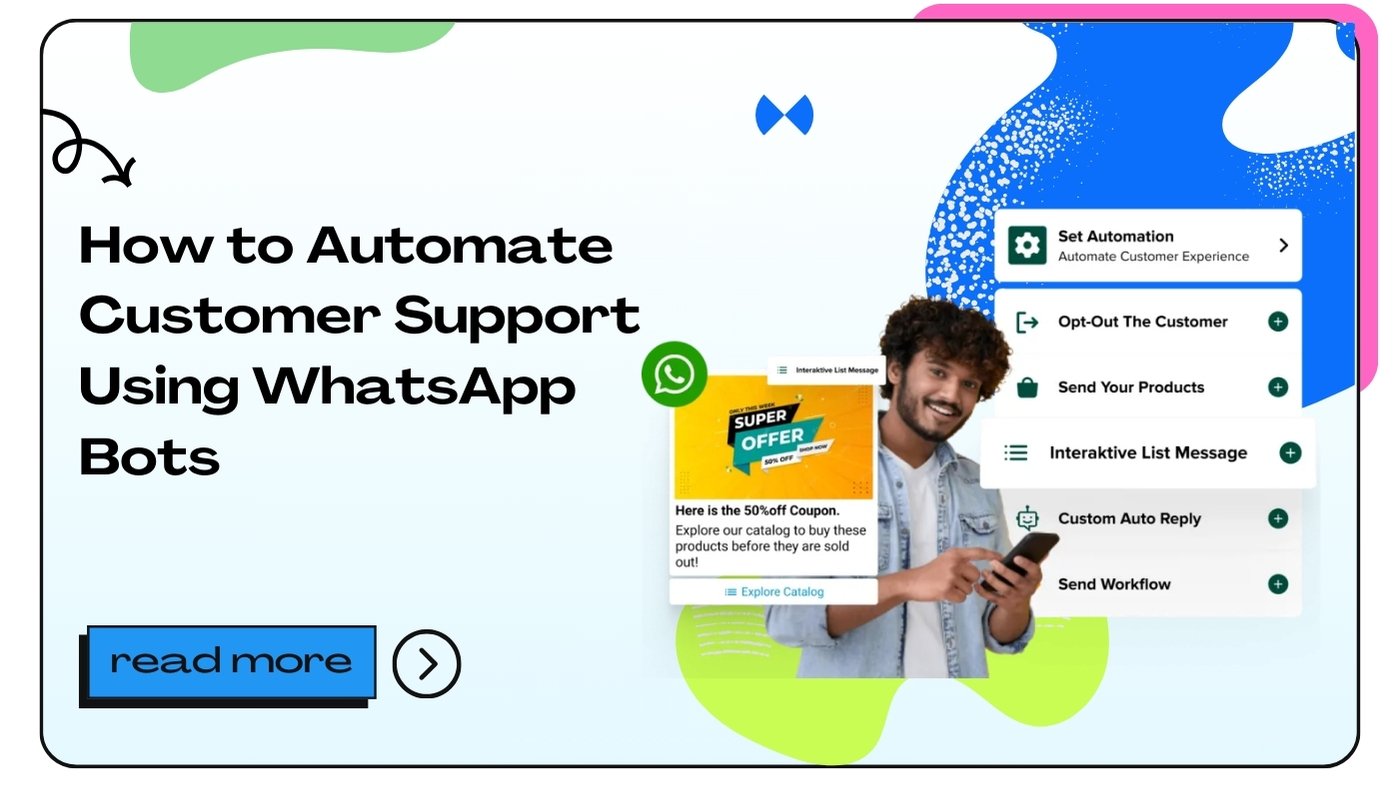Automating customer support through WhatsApp bots is a powerful strategy that businesses can leverage to improve their communication with clients. WhatsApp, with over 2 billion users worldwide, presents an unparalleled opportunity for businesses to engage customers in a familiar environment. But what exactly are WhatsApp bots, and how can they benefit your customer support system?
What Are WhatsApp Bots?
WhatsApp bots are automated programs that interact with users via the WhatsApp messaging platform. These bots can respond to customer inquiries, provide information, and perform tasks without human intervention. By leveraging artificial intelligence and natural language processing, WhatsApp bots can understand user queries and respond appropriately, ensuring that customers receive timely assistance.
The Importance of Automation in Customer Support
Automation in customer support is crucial for several reasons:
- Efficiency: Bots can handle multiple customer inquiries simultaneously, reducing wait times and improving overall service speed.
- Cost-Effectiveness: By automating routine inquiries, businesses can free up human agents to focus on more complex issues, optimizing resource allocation.
- Availability: WhatsApp bots can provide 24/7 support, ensuring customers receive assistance outside regular business hours.
- Consistency: Bots deliver standardized responses, reducing the risk of human error and ensuring consistent information across all interactions.
In the following sections, we will delve deeper into the benefits, implementation strategies, and best practices for using WhatsApp bots to automate customer support effectively.
Benefits of Automating Customer Support with WhatsApp Bots
Enhanced Customer Experience
One of the primary benefits of implementing WhatsApp bots in customer support is the enhanced user experience. Customers today expect quick and efficient service, and bots can meet these demands by providing instant responses to inquiries.
Key Aspects of Improved Customer Experience:
- Quick Responses: Bots can immediately address frequently asked questions, ensuring customers do not have to wait for a human agent.
- Personalization: Advanced bots can analyze user data and provide personalized recommendations, making interactions feel more tailored.
- User-Friendly Interface: WhatsApp is familiar to many users, reducing the learning curve and making it easier for customers to engage.
Increased Efficiency
WhatsApp bots streamline customer support processes by automating repetitive tasks. This efficiency can lead to significant time savings for both customers and support teams.
How Bots Increase Efficiency:
- Automated FAQs: Bots can answer common questions without human intervention, freeing agents to focus on more complex inquiries.
- Ticket Creation: Bots can automatically create support tickets for unresolved issues, ensuring no inquiries go unnoticed.
- Data Collection: Bots can gather customer feedback and data for analysis, helping businesses understand customer needs better.
Cost Savings
Implementing WhatsApp bots can lead to substantial cost savings for businesses. By reducing the need for a large support team and minimizing operational costs, organizations can allocate resources more efficiently.
Cost-Saving Benefits:
- Reduced Labor Costs: Fewer human agents are needed to handle routine inquiries, leading to lower labor expenses.
- Minimized Training Costs: With bots handling basic questions, training costs for new hires can be reduced.
- Less Infrastructure Investment: Bots operate on existing platforms, requiring less additional investment in customer support infrastructure.
Data Insights and Analytics
WhatsApp bots can collect and analyze data from customer interactions, providing businesses with valuable insights into customer behavior and preferences.
Benefits of Data Insights:
- Customer Preferences: Analyze inquiries to understand what products or services are most popular among customers.
- Common Pain Points: Identify frequent issues raised by customers to improve products or services.
- Performance Metrics: Track bot performance, including response times and customer satisfaction, to optimize the support process continually.
Key Features of WhatsApp Bots for Customer Support
Natural Language Processing (NLP)
Natural Language Processing is a critical feature of WhatsApp bots. NLP enables bots to understand and interpret human language, allowing for more natural and engaging conversations.
How NLP Enhances Interaction:
- Understanding Context: NLP allows bots to understand the context of user inquiries, leading to more accurate responses.
- Handling Variations: Bots can recognize and respond to various phrasings of the same question, improving user experience.
- Sentiment Analysis: Advanced NLP capabilities enable bots to gauge user sentiment and adjust responses accordingly.
Rich Media Support
WhatsApp bots can send and receive rich media, such as images, videos, and documents, enhancing communication and providing users with valuable information.
Examples of Rich Media Use:
- Product Images: Bots can send product images in response to inquiries, providing visual support to customers.
- Tutorial Videos: Customers can receive video links for troubleshooting or how-to guides, improving their understanding.
- Documents and Files: Bots can share PDFs, manuals, or other important documents, allowing for seamless information sharing.
Integration with CRM Systems
Integrating WhatsApp bots with Customer Relationship Management (CRM) systems can enhance customer interactions by providing bots with access to user data.
Benefits of CRM Integration:
- Personalized Support: Bots can access customer history and preferences, providing personalized assistance based on past interactions.
- Seamless Ticketing: Integration with CRM allows for seamless ticket creation and tracking, improving resolution times.
- Centralized Data: Access to customer data across platforms helps businesses maintain a comprehensive view of customer interactions.
Multi-Language Support
In today’s global marketplace, multi-language support is essential. WhatsApp bots can be programmed to communicate in multiple languages, catering to diverse customer bases.
Advantages of Multi-Language Support:
- Broader Reach: Businesses can engage with customers from various regions and backgrounds.
- Improved Accessibility: Providing support in users’ preferred languages enhances accessibility and user experience.
- Cultural Relevance: Tailoring conversations to local languages fosters trust and connection with customers.
Implementing WhatsApp Bots for Customer Support
Defining Objectives and Goals
Before implementing WhatsApp bots, businesses should define their objectives and goals for automation. Understanding the purpose of the bot will guide its design and functionality.
Key Considerations:
- Identify Common Inquiries: Analyze historical customer support data to identify the most common inquiries that can be automated.
- Set Success Metrics: Establish metrics for measuring the bot’s success, such as response times, customer satisfaction scores, and issue resolution rates.
- Define Scope: Determine the scope of the bot’s capabilities, including the types of inquiries it will handle and the processes it will automate.
Choosing the Right Bot Development Platform
Selecting a suitable bot development platform is crucial for successful implementation. Several platforms offer tools for building and managing WhatsApp bots.
Factors to Consider:
- Ease of Use: Look for a platform with a user-friendly interface that simplifies bot development and management.
- Integration Capabilities: Choose a platform that can easily integrate with your existing systems, such as CRMs and helpdesk software.
- Scalability: Ensure the platform can scale with your business as your needs evolve.
Designing Conversational Flows
Designing effective conversational flows is essential for ensuring smooth interactions between users and WhatsApp bots.
Best Practices for Conversational Design:
- Use Simple Language: Write clear and concise responses that are easy for users to understand.
- Incorporate Quick Replies: Offer quick reply buttons for common responses, making it easier for users to interact with the bot.
- Allow for Human Escalation: Provide options for users to escalate to a human agent if their inquiries are too complex for the bot to handle.
Testing and Iteration
Before launching your WhatsApp bot, thorough testing is essential to ensure it functions as intended.
Testing Steps:
- Simulate User Interactions: Conduct simulations of user interactions to identify potential issues or areas for improvement.
- Gather Feedback: Involve a group of beta testers to provide feedback on the bot’s performance and user experience.
- Iterate Based on Feedback: Make necessary adjustments to the bot’s functionality and conversational flows based on user feedback.
Monitoring and Optimizing Bot Performance
Tracking Key Performance Indicators (KPIs)
Monitoring the performance of your WhatsApp bot is crucial for continuous improvement. Establish key performance indicators (KPIs) to assess the bot’s effectiveness.
Common KPIs to Track:
- Response Time: Measure the average time taken by the bot to respond to user inquiries.
- User Engagement: Track the number of users interacting with the bot and their engagement levels.
- Resolution Rates: Analyze the percentage of inquiries successfully resolved by the bot without human intervention.
Continuous Improvement Strategies
To ensure your WhatsApp bot remains effective, implement continuous improvement strategies based on performance data and user feedback.
Strategies for Improvement:
- Regular Updates: Update the bot’s knowledge base and conversational flows regularly to keep up with changing customer needs.
- A/B Testing: Experiment with different conversational designs and features to identify what resonates best with users.
- User Feedback Loop: Establish a feedback loop to gather ongoing user feedback and make necessary adjustments.
Leveraging Data for Insights
The data collected from customer interactions can provide valuable insights into customer behavior and preferences.
How to Use Data Insights:
- Identify Trends: Analyze interaction data to identify trends and patterns in customer inquiries.
- Enhance Personalization: Use insights to personalize interactions and tailor responses based on user preferences.
- Optimize Marketing Strategies: Leverage data to inform marketing strategies and improve targeting based on customer behavior.
Best Practices for Using WhatsApp Bots in Customer Support
Maintain a Human Touch
While automation is beneficial, maintaining a human touch in customer interactions is essential. Ensure that users feel valued and understood throughout their interactions.
Ways to Maintain Human Connection:
- Empathetic Responses: Train the bot to respond empathetically to customer emotions and frustrations.
- Friendly Tone: Use a friendly and conversational tone in bot responses to create a welcoming atmosphere.
- Personalization: Address users by name and offer personalized recommendations based on their preferences.
Educate Users About the Bot’s Capabilities
Providing users with clear information about the bot’s capabilities can enhance their experience and set appropriate expectations.
Educational Strategies:
- Welcome Message: Create a welcoming message that introduces the bot and its functionalities.
- FAQs: Develop a FAQ section that outlines common inquiries the bot can handle.
- Feedback Request: Encourage users to provide feedback on their interactions, fostering a sense of involvement.
Regularly Update Content
To keep the bot relevant and helpful, regularly update its content and knowledge base.
Updating Strategies:
- Monitor Industry Changes: Stay informed about industry trends and update the bot’s knowledge base accordingly.
- Seasonal Updates: Make seasonal updates to reflect promotions, events, or changes in products or services.
- User-Sourced Content: Encourage users to provide feedback on topics they want the bot to address.
Be Transparent About Automation
Transparency is vital when implementing automation. Let users know they are interacting with a bot, ensuring they have a clear understanding of the interaction.
Transparency Practices:
- Introduce the Bot: Clearly indicate when a user is interacting with a bot, providing an introduction.
- Offer Human Escalation: Make it easy for users to request assistance from a human agent if needed.
- Honesty About Limitations: Be upfront about what the bot can and cannot do, preventing user frustration.
20 Unique FAQs About Automating Customer Support with WhatsApp Bots
- What is a WhatsApp bot?
A WhatsApp bot is an automated program that interacts with users on the WhatsApp platform, providing responses and assistance without human intervention. - How can WhatsApp bots improve customer support?
They enhance customer support by providing quick responses, 24/7 availability, and efficient handling of common inquiries. - What features should I look for in a WhatsApp bot?
Look for natural language processing, multi-language support, rich media capabilities, and integration with CRM systems. - Can WhatsApp bots handle complex customer inquiries?
While bots can handle many inquiries, they may need to escalate more complex issues to human agents. - How do I get started with implementing a WhatsApp bot?
Define your objectives, choose a bot development platform, design conversational flows, and conduct thorough testing before launch. - What are the benefits of using WhatsApp for customer support?
WhatsApp offers a familiar platform for users, quick response times, and the ability to send rich media for enhanced communication. - How do I measure the success of my WhatsApp bot?
Track key performance indicators such as response times, user engagement, and resolution rates to assess the bot’s effectiveness. - What are some common use cases for WhatsApp bots?
Common use cases include answering FAQs, providing product recommendations, scheduling appointments, and processing orders. - How can I ensure my bot maintains a human touch?
Use empathetic responses, a friendly tone, and personalization to create a welcoming experience for users. - What are the limitations of WhatsApp bots?
Limitations include the inability to handle highly complex inquiries and the potential for miscommunication if the bot fails to understand user intent. - How do I keep my WhatsApp bot updated?
Regularly monitor industry trends, seasonal updates, and user feedback to ensure the bot remains relevant and helpful. - Can WhatsApp bots integrate with existing systems?
Yes, many bot development platforms offer integration capabilities with CRM systems and other software. - Is it necessary to provide a human escalation option?
Yes, providing an option for users to connect with human agents is essential for handling complex issues and enhancing user satisfaction. - How can I collect user feedback on my WhatsApp bot?
Encourage users to provide feedback through follow-up messages or surveys after their interactions with the bot. - What should I include in the bot’s welcome message?
The welcome message should introduce the bot, outline its capabilities, and provide options for common inquiries. - How can I ensure my bot is user-friendly?
Use simple language, incorporate quick replies, and test the bot with real users to gather feedback on its usability. - What is natural language processing (NLP)?
NLP is a technology that enables bots to understand and interpret human language, allowing for more natural interactions. - Can WhatsApp bots handle multiple languages?
Yes, WhatsApp bots can be programmed to communicate in multiple languages, catering to a diverse customer base. - What types of businesses can benefit from WhatsApp bots?
Various businesses, including retail, hospitality, healthcare, and e-commerce, can benefit from WhatsApp bots in customer support. - How can I ensure my WhatsApp bot complies with data privacy regulations?
Implement data protection measures, inform users about data collection practices, and adhere to relevant regulations like GDPR.
- WhatsApp Payments: A Beginner’s Guide to Digital Transactions - October 4, 2024
- How to Use WhatsApp Web: Features, Shortcuts, and Tips - October 4, 2024
- WhatsApp’s Role in the Future of E-Commerce - October 4, 2024




















